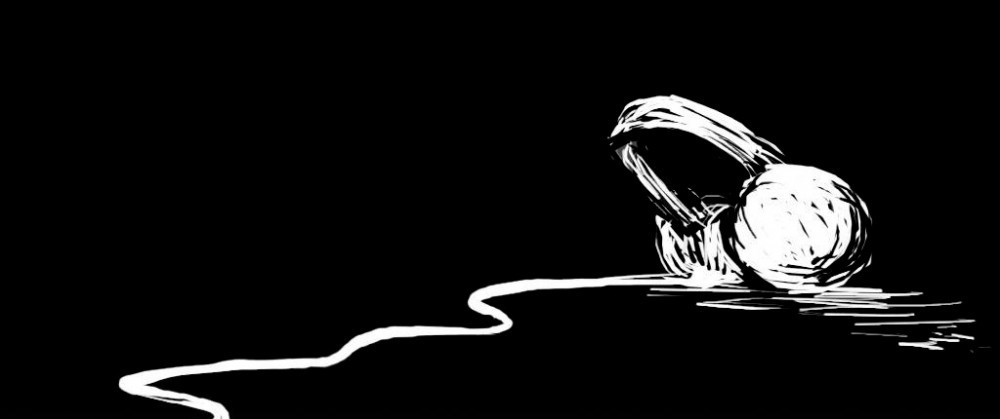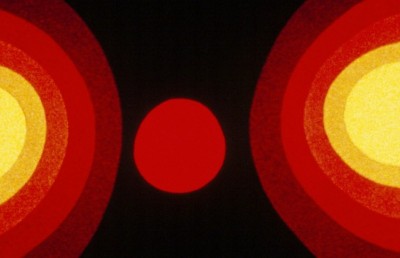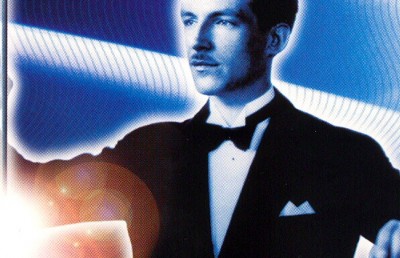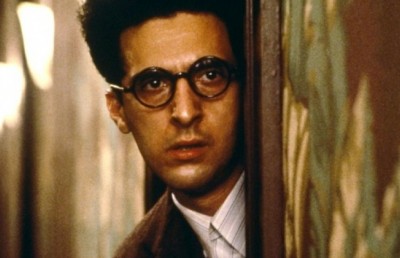Headphones, Epoche, and L’extimité: A Phenomenology of Interiority
On the Audiowalks of Cardiff and Miller

Editor’s Intro:
In our final feature essay, Charles Stankievech keeps us firmly rooted within the realm of sound. Yet like the other essays in this issue, he too is interested in the blurring of a boundary line: that between the experiences of interiority and exteriority as mediated by headphone technologies. Bracketed by the phenomenological inquiries of Husserl and Merleau-Ponty as well as the psychoanalytic writings of Freud and Lacan, Stankievech examines the concept of interiority through a discussion of the audiowalks created by Janet Cardiff and George Miller. Their work makes an excellent case study for considering issues relating to interiority within the context of sound-art practice. Ultimately Stankievech offers some fascinating points of entry into the discourses surrounding the body as a site of mediation between interiority and exteriority, and the role of headphone technologies in collapsing this mediation. -RJ
__________
A history and a phenomenology of interiority (which we perhaps lack) should here join a history of a phenomenology of listening. – Roland Barthes
A legion of disembodied voices float in the air today: from car radios to ipods, from parabolic speakers to multi-channel sound fields. In the midst of this continuing assault, the following question surfaces in the maelstrom: where does our subjectivity begin and where does it end? What is our inside and what is our outside? When we use the term phenomenology we think of our experience of the surrounding environment, but can there also be a phenomenology of the interior? If so, what would it sound like? Roland Barthes suggests we perhaps lack this phenomenology, while Bruce Nauman seems to touch upon a certain instinctive prohibition that runs deep in our nervous system with his sound installation “Get out of this room, Get out of my mind”. 1 Negotiating a membrane between exterior and interior, the pressing question emerges, where should we set the brackets of our phenomenological epoche? 2 As a temporary strategy, shall we play deaf to “Descarte’s Error” and choose the intuitive as a starting place? Shall we set our brackets at the perimeter of our head—at our ears? Continuing the trajectory of listening first established by the medical stethoscope, this essay seeks to explore role of headphones in shaping both our acoustic perception of the world and the spatial organisation of our subjectivity.
Throughout the twentieth century, the concept of ‘interiority’ has been treated with suspicion in certain areas of the sciences and philosophy. One of the strongest critiques came from Merleau-Ponty’s elegant reworking of Husserl’s notion of phenomenology, where the starting point is the subject, described as an entity embodied in the world of the everyday. In this context, the term ‘interior’ itself becomes a pejorative. As Merleau-Ponty points out, interiority is born, at least in part, from a historical and religious sense of being that is rooted in Christian mystical language. St Augustine’s “interiore homine,” for example. Rooted in the body’s experience, Merleau-Ponty finds fault with Augustine’s neo-Platonist conception: “Truth does not ‘inhabit’ only the ‘inner man’, or more accurately, there is no inner man, man is in the world, and only in the world does he know himself.” (Merleau-Ponty 1962:xi) 3 Interiority is not, however, solely the product of religion nor a derelict relic of it. In the last few centuries, a parallel path developed in medicine and technology has fostered a different type of interiority, making it once again a contemporary issue. Is it possible, therefore, to conceptualise ‘interiority’ in a non-Euclidian manner rather than as a mystical utopia or non-place? What would that mean? Our first step toward doing so lies in considering what it means to conceive of space that is in one’s head. I am not referring here to the fantastical imagination, but more the spatial possibility of ‘in-head’ acoustics.
Oliver Sacks’ essay “The Mind’s Eye: What the Blind See” is an interesting example of the type of interior conceptualisation the mind is capable of in spite of blindness. Sacks recounts various examples of blind people whose interactions with the external world are visually created via alternative modes of perception and re-organised cerebral processing. In these poignant stories of people blinded after birth and thus possess a developed visual cortex, spatial perceptions are neither wholly exterior realism nor wholly interior fantasy. Blinded quite late in his life, John Hull describes his pointillist perception of a landscape covered by rain:
Rain has a way of bringing out the contours of everything; it throws a coloured blanket over previously invisible things; instead of an intermittent and thus fragmented world, the steadily falling rain creates continuity of acoustic experience…presents the fullness of an entire situation all at once…gives a sense of perspective and of the actual relationships of one part of the world to another (Sacks 2003:50).
While for some blind people this perceived world is constructed as exterior, Sacks describes others who can turn objects three dimensionally in their mind. Not limited by stereoscopic vision, some blind people such as Zoltran Torrey and Bernard Morin, have developed a “hyperacuity that perhaps no sighted person can imagine” (51). The mathematician Morin, for example, showed in the 1960’s how to turn a sphere inside out. Blindness certainly poses difficulties for these people, but it also fosters an engagement with the world that is just as spatial if it were based on visual datum. For them, space is more intrinsically relational and imbued with a strangely ambiguous separation between interiority and exteriority.
Challenging the dogma that sound is about temporality and vision about spatiality, Sacks’ essay opens up the world of space and architecture imagined apropos sound. In itself, imaging a world based on sound is not a novel idea. It is a common technique used by animals and, with the help of technology, humans. David Griffin discovered in 1938 that bats use sonic pulses to navigate and termed this process Echolocation. Technological echolocation is used in both radar and sonar, in non-destructive testing ultrasonics and in medical ultrasonography. It is also used in architectural acoustics, where a spark of sound is released in a space. The resulting reverberation signal provides an acoustic impression of the space. If recorded, this acoustic impression can be applied to any sound file to create a virtual rendering of this sound file as if it were played in the recorded space. What is novel about Sacks’s research is how the senses remap their perceptions naturally to create an alternative, and yet acute, sense of space. The ability to composite a space “in one’s mind” and retain this impression allows for a special mental ability of manipulation and analysis. While linguistic grammar embedded in a traditional cultural assumption of consciousness directs us into thinking that this alternative space is interior, the phrase “in the mind” is not the same thing as “in the head.” Distinguishing this difference in turn highlights the unusual, and yet essential, relation between imagination and space.
Perhaps the closest way for visual people to experience the type of acute acoustic perception that some blind people possess—without taking amphetamines like Oliver Sacks or hallucinogens like Aldous Huxley—is to listen to sound with headphones. William Gibson enthusiastically recognized the power of headphones for changing human perception: “the Sony Walkman has done more to change human perception than any virtual reality gadget. I can’t remember any technological experience since that was quite so wonderful as being able to take music and move it through landscapes and architecture” (Gibson 1993:49). 4 Coming from the mind that initially envisioned cyberspace in his novel Neuromancer, this is quite a proclamation.
A modern technological prosthetic, headphones are quite literally a bracketing of the world for a precise analysis of sound. It is here then that a concentrated investigation of a phenomenology of interiority can occur. With headphones a unique acoustic experience can be created unlike anything else in the history of listening—the closest being the stereo stethoscope. 5 According to Jonathan Sterne, the stethoscope first develops the technique of listening that continues in the technology of headphones. Specifically, headphones continue the techniques of isolation and amplification first fostered by the use of the stethoscope. 6 But while the stereo stethoscope allows for a transposition of a real space onto an imaginary space (from heart chamber to headspace), headphones allow for the creative manipulation of any kind of sound – from natural to technical to musical – to create imaginary spaces within another imaginary space.
There are three requirements necessary to maintain the experience first established by stethoscope audition – the ‘space between the ears’: first, an identical sound source is presented to both ears at the same volume levels (inter-aural amplitude difference); second, an absence of any temporal delay in perceiving the sound event between the ears (inter-aural time difference); and third, a lack of the cross-talk and phasing present with loudspeakers. Because sound enters directly into the ear canal when using headphones, normal Head Related Transform Functions are bypassed. Combined, these three specifications allow for a sound event which places a ‘sound mass’ (Varèse) inside the head. It should be noted that this type of listening was the typical experience available until the invention of the stereo headphone (usually attributed to Koss in 1958). In contrast, it is the norm today that stereo headphones playing binaural recordings, M-S stereo recordings, or ambisonic recordings create a 3D impression that accurately replicates an exterior perception of the world. In turn, it is the juxtaposition of these two modes of listening—in-head spatialisation and exterior stereo soundfields—which best reveals the peculiarity and effects of ‘in-head’ positioning.
While several sound artists are currently exploring in-head spatial characteristics, 7 artists Janet Cardiff and George Miller effectively play with “in-head” space versus “outer-space.” Collaboratively, their sound work ranges from model cinemas to 40 channel recordings. However, their most common sonic technique is the binaural recording for their audiowalks. Echoing the soundscape works of R. Murray Schafer, Barry Traux and Hildegard Westerkamp from the 1970’s (Schafer 1977), in Cardiff and Miller’s audiowalks, a listener wears a pair of headphones with a pre-recorded soundtrack overlaid upon the actual route that the listener is instructed to walk along in the city. Deceptively simple looking, Cardiff and Miller’s audiowalks should be read alongside Gibson’s claim that Walkmans are the most effective VR device invented thus far. I doubt this has changed. It is headphones’ relative transparency which is in turn its driving force.
By using headphones Cardiff and Miller’s work reveals the strange ambiguity of the subject’s exterior/interior. The outside is recreated in a postulated soundfield beyond the source of the small speakers pressed to the ears. Playing on the isolation of the subject’s acoustic perception of the exterior world and substituting the banality of the everyday with their own manipulated cinematic version, a strange orientation occurs. This strange orientation is not due to a loss of reality but to a supplement to reality. Nor does one become lost in reality. Instead listeners enter a hybrid state where they play a dramatic role that contrasts with everyday life and which is directly interpellated into their minds by the instructional voice of Cardiff.
The spatiality of Cardiff’s voice stands out from the rest of the binaural recording of the soundscape, and it is this difference which creates the strongest effect on the listener. Her voice is recorded in close proximity to the microphone and in mono. On a few pieces, such as A Large Slow River and Villa Medici Walk, her voice contrasts with Miller’s voice who we also hear on the recording. His voice is also recorded monaurally. However, it has been processed as a noisy tape-recording. The result is a mediated voice that keeps its distance from the listener further highlighting the unmediated and direct call of Cardiff’s voice, which is continually “out-of-field” or out of the frame. 8 The result: Her voice feels like it speaks from within the listener’s own body rather than from the soundscape. The out-of-frame is commonly associated with the act of perception itself—that which creates the frame and is thus excluded. This confusion between the exterior/interior creates a sense of what one might refer to as the unheimlich, a reflection that is somewhat true.
But perhaps a way to engage Cardiff and Miller’s work—and headphone listening in general—is not through Freud’s concept of the unheimlich, but Lacan’s topologically structured term l’extimité. Developed in the later phase of Lacan’s writing, 9 the idea of the l’extimité continues the importance of the voice in the psychoanalytic tradition since Freud first outlined the foundations for the “talking cure.” In short, L’extimité is a neologism by Lacan that combines exteriority and intimacy. Linked to other terms, like das Ding, Lacan defines the concept as that “something strange to me, although it is at the heart of me” (Lacan 1992:71). This description could be used to describe the general experience of listening with headphones. More specifically, listening to a phantom voice with headphones is the ideal example of l’extimité. In an impossible space that links the exterior with the interior via the topology of a möbius loop (or better yet a Klein bottle), the subject listens. Or shall I say the outside is on the inside of the listener? Definitions become blurred. The difference between contained and container slides, as does the difference between I and Thou. We easily identify with our phantasies once we have become the Hollow Men making room for an Other. Janet’s words command me to listen, and touched by a phantom intimacy, I do. Confessing with the words of Roland Barthes, “The Other collects [her] whole body in [her] voice and announces that I am collecting all of myself in my ear” (Barthes 1972:252)
*A much longer version of this paper exploring auscultation and several more sound artists was delivered at Subtle Technologies 2006 and a shorter version was published in Responsive Architectures (Riverside Press 2006).
Sources Cited:
Amacher, Maryanne. (1999). Sound Characters: Making the Third Ear. NY: Tzadik #7043. Audio CD.
Barthes, Roland. (1972). Listening. Critical Essays, trans. Richard Howard. Evaston, IL: Northwestern University.
Leitner, Bernhard. (2003). Kopfräume – Headscapes. Hatje Cantz: Edition ZKM. Audio CD with notes.
Cardiff, Janet. (2000). A Large Slow River. Oakville: Oakville Gallery. Audio CD.
Cardiff, Janet. (2001). Villa Medici Walk. Janet Cardiff: A Survey of Works Including Collaborations with George Bures Miller. Long Island City, NY: PS1. Audio CD.
Freud, Sigmund. (2001). The Uncanny. Reprinted in Literary Theory: An Anthology, eds. Julie Rivkin & Michael Ryan. London: Blackwell.
Gibson, William. (1993, October 6th). Time Out, 49.
Husserl, Edmund. (1932). Phenomenology. Encyclopedia Britannica, 14th edition, Encyclopedia Britannica, Inc. Cited in Twentieth-Century Philosophy, eds. Forrest E. Baird & Walter Kauffman. 2nd edition. Philosophic Classics: Volume V. Upper Saddle River, NJ: Prentice Hall, 2000.
Ikeda, Ryoji. (1996). +/-. London: Touch, 30. Audio CD.
Ikeda, Ryoji. (1998). 0˚C. London: Touch 38. 1998. Audio CD.
Lacan, Jacques. (1977). The Four Fundamental Concepts of Psychoanalysis: Book XI, trans. Alan Sheridan. NY: W.W. Norton & Company.
Lacan, Jacques. (1992). The Ethics of Psychoanalysis. Book VII, trans. Dennis Porter. London: Routledge.
Nauman, Bruce. (1968). Get out of my mind, get out of this room. Collection of Jack Wendler.
Merleau-Ponty, Maurice. (1962). Phenomenology of Perception, trans. Colin Smith. London: Routledge.
Sacks, Oliver. (2003, July 23). A Neurologist’s Notebook: The Mind’s Eye: What the Blind See. The New Yorker, 48-59.
Stankievech, Charles. (2006). Möbius Fields. Leonardo Music Journal, 16. Cambridge, MA: MIT Press. Audio CD and Writing.
Sterne, Jonathan. (2003). The Audible Past: Cultural origins of sound reproduction. Durham: Duke University Press.
Toole, F. E. (1592/1967). In-Head Localization of Acoustic Images. Acoustic Society of America, 41.
Wollscheid, Achim. (1996). The Terrorized Term. Frankfurt: Selektion.
Author Bio:
Charles Stankievech has formally studied theology, literature, philosophy, and fine art (B.A Honours, MFA). Recently, his work has been presented at the Planetary Collegium’s Altered States, England; Eyebeam, NYC; Subtle Technologies’ Responsive Architectures, Toronto; artLAB residency, Venice, Italy; and MIT Press’ Leonardo Music Journal. In 2007, he will be attending residencies at the Banff Centre for the Arts and PRIM. While completing his MFA he also taught specialized sound courses such as “Sound Drawing Architecture” and “Sculptural + Material Practices” at Concordia University in Montréal, and now teaches full-time at KIAC School of Visual Art in Dawson City, Yukon, Canada. For more information, visit: http://www.stankievech.net.
PDF Downloads
- Headphones, Epoche, and L’extimité: A Phenomenology of Interiority by Charles Stankievech
- Roland Barthes: “A history and a phenomenology of interiority (which we perhaps lack) should here join a history of a phenomenology of listening”. “Listening”, Critical Essays. Trans. Richard Howard. Evaston, IL: Northwestern University P., 1972, p 250; Bruce Nauman, “Get out of my mind, get out of this room” (Collection Jack Wendler, 1968), and Raw Materials (London: Tate Modern), 12 October 2004 – 2 May 2005. ↩
- Husserl’s definition and use of the intellectual tool epoche: “Our comprehensive epocheputs, as we say, the world between brackets, excludes the world which is simply there! from the subject’s field, presenting in its stead the so-and-so-experienced-perceived-remembered-judged-thought-valued-etc., world, as such, the “bracketed” world. Not the world or any part of it appears, but the “sense” of the world. To enjoy phenomenological experience we must retreat from the objects posited in the natural attitude to the multiple modes of their “appearance,” to the “bracketed” objects.” Edmund Husserl. “Phenomenology” Encyclopedia Britannica, 14th edition, 1932, Encyclopedia Britannica, Inc. Reprinted in Twentieth-Century Philosophy. Eds. Forrest E. Baird & Walter Kauffman. 2nd edition. Philosophic Classics: Volume V. Upper Saddle River, NJ: Prentice Hall, 2000. ↩
- Merleau-Ponty’s text footnotes Augustine: “In te rei; in interiore homine habitat veritas” ↩
- Quoted in M. Bull. Though Gisbon is referring specifically to the brand name “Walkman” and making reference to how it allowed urban mobility, it is actually the headphones of the walkman which are most impressive and unique. Already with the car radio people could listen to music while driving through landscapes and architecture. See Achim Wollshied for a discussion of the automobile radio. The Terrorized Term. 72-89. ↩
- A rare exception occurring in laboratory tests or extreme noise environments where the middle ear is overloaded, i.e. a Maryanne Amacher installation. For a technical discussion see: E. F.Toole. In-Head Localization of Acoustic Images. ↩
- See Jonathan Sterne’s The Audible Past which gives a thorough historical overview of the stethoscope’s invention and development within a set of cultural practices. Because of Sterne’s interest in cultural history, his work explores social space, while this present essay is interested in psychoacoustic and architectural acoustic space. ↩
- See: Ryoji Ikeda’s +/- or 0˚C (Touch), Bernhard Leitner’s Headspaces (Edition ZKM), and Maryanne Amacher’s Sound Characters: making the third ear (Tzadik); as well as the present author’s own sound work, Stankievech’s Möbius Fields (MIT Press). ↩
- My decision to call these works collaborative between Janet Cardiff and George Miller is important. George’s heavily mediated voice on the tape signifies his role as what is sometimes called the vanishing mediator. Recorded symbolically, we posses the ‘license to forget.’ ↩
- Lacan’s work is usually broken down into three phases which “coincidentally” coincide with his three orders: Imaginary, Symbolic and Real. Barthes’ essay discussed at the beginning of this paper is working from Lacan’s middle and best known phase: the structuralist period. This is evident in the uncited quotation of Lacan that Barthes uses: “the unconscious, structured like a language” in Barthes p. 252, and originally in Lacan (among many places): p. 20. The Four Fundamental Concepts of Psychoanalysis: Book XI. Trans. Alan Sheridan. NY: W.W. Norton & Company, 1977. Avant la letter of Barthes, Lacan begins his “phenomenology of the interior” based on Hegel and Heidegger. ↩
Notes













